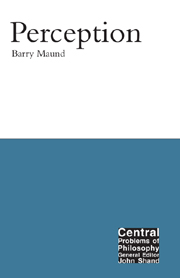Book contents
- Frontmatter
- Contents
- Preface
- 1 The philosophy of perception
- 2 A theory of natural realism
- 3 Theories of perceptual experiences
- 4 Representationalism: representations as natural signs
- 5 Natural realism: Putnam, Austin and Heidegger
- 6 Perception: the argument from illusion
- 7 The phenomenal and phenomenological senses of “looks”
- 8 Types of perceptual content
- 9 The representationalist–intentionalist thesis
- 10 Adverbialist accounts of perceptual experience
- Conclusion
- Notes
- References
- Index
10 - Adverbialist accounts of perceptual experience
- Frontmatter
- Contents
- Preface
- 1 The philosophy of perception
- 2 A theory of natural realism
- 3 Theories of perceptual experiences
- 4 Representationalism: representations as natural signs
- 5 Natural realism: Putnam, Austin and Heidegger
- 6 Perception: the argument from illusion
- 7 The phenomenal and phenomenological senses of “looks”
- 8 Types of perceptual content
- 9 The representationalist–intentionalist thesis
- 10 Adverbialist accounts of perceptual experience
- Conclusion
- Notes
- References
- Index
Summary
Perceptual experiences, we have agreed, have both phenomenal (sensuous) character and intentional content. In Chapter 9 I examined the theory that attempts to explain phenomenal character in terms of the intentional content or, more accurately, the non-conceptual, representational content of the experience. I argued that it was not successful. In particular it suffered in comparison with those theories that accounted for phenomenal character in terms of intrinsic phenomenal qualities of phenomenal items. Examples of such theories are the traditional sense-datum theories but another important example is the natural-sign theory that I have championed. On this theory, the naive perceiver takes the signs as signs of physical objects and their qualities, but does not conceptualize them as signs.
According to this last group of theories, perceptual experience has a certain structure: it consists in the awareness of phenomenal items, or of quality-instances. As was discussed in Chapter 3, this structure fits an act–object structure. The fact that these theories imply that perceptual experiences have an act–object structure is of great importance, for there is a significant body of philosophers, both traditional and contemporary, who reject this analysis, including Reid, Ducasse, Chisholm, B. Aune and, more recently, Dretske and Tye. What they offer in its place is an adverbialist account of perceptual experience.
One of the earliest and most explicit of critics of the act–object analysis was Reid. He argued that it was crucial in accounts of perception to distinguish perception from sensation.
- Type
- Chapter
- Information
- Perception , pp. 193 - 208Publisher: Acumen PublishingPrint publication year: 2002



